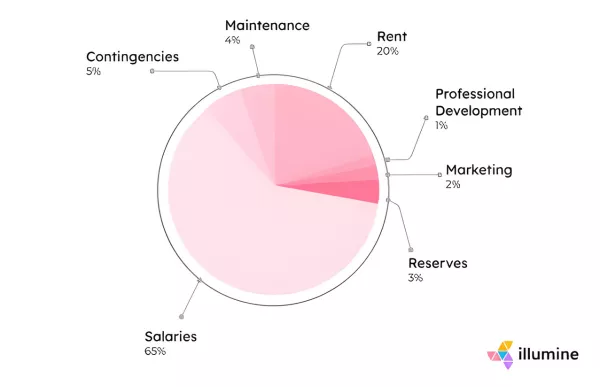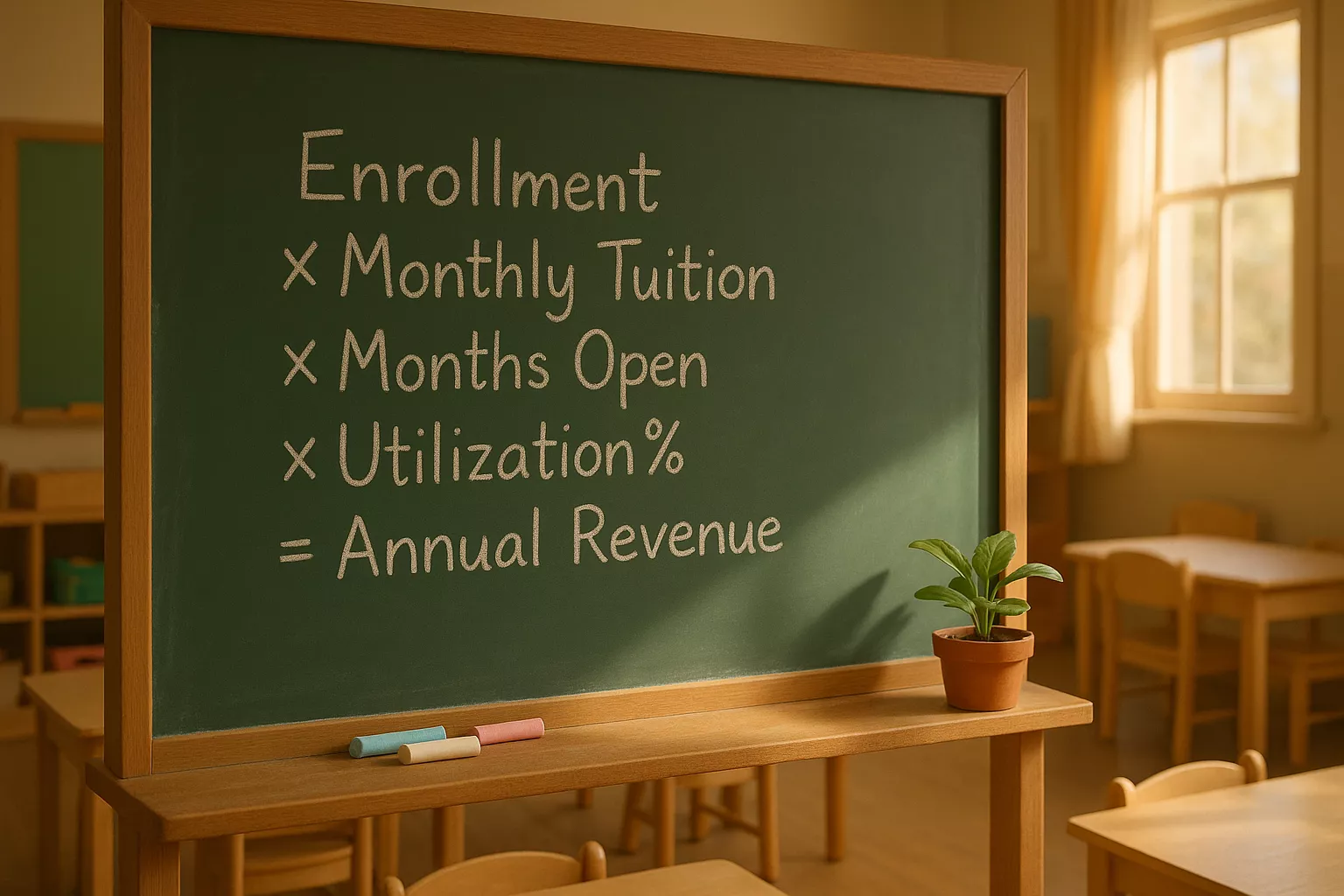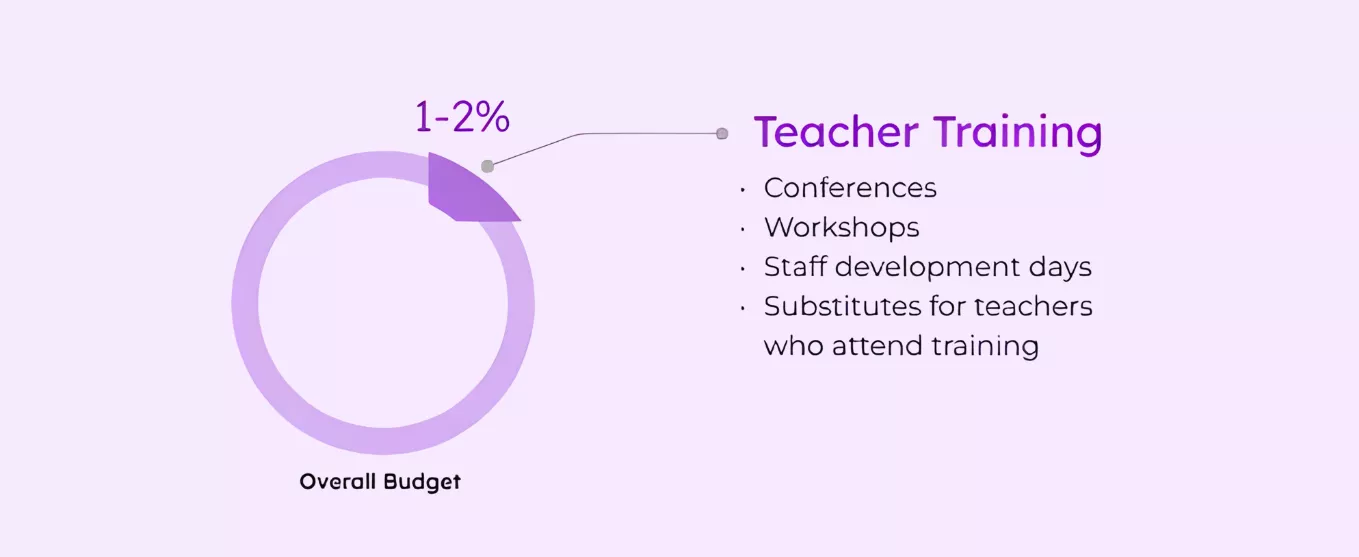Building a preschool is not only about a beautiful environment or great teachers. It is also about a strong community and a sustainable financial model that allows both people and spaces to thrive.
A well designed daycare budget is both a map and a mirror. It shows where your school is going and reflects what you value most. Whether you are opening your doors for the first time or fine tuning an established program, it helps to understand each element of your budget and how it fits into the larger picture of daycare bookkeeping.
Before we dive into each line item, here is a quick view of how the budget fits together.
Quick View: How a Preschool Budget Works
A budget tracks money in and money out. In daycare bookkeeping, income usually comes from tuition, administrative fees, and sometimes grants.
Costs split into fixed items such as rent, core salaries, and insurance, and variable items such as food, supplies, and utilities.
Aim for a modest surplus each year so you can reinvest, protect your daycare profit margin, and handle the unexpected.
The Core Elements of a Preschool Budget

In-Depth Look Into the Components of Daycare Bookkeeping
1. Rent or Mortgage: Your Largest Fixed Cost
For most preschools, facility costs are the single most significant expense.
If you lease your space, rent may include property taxes and insurance. If you own, you will have mortgage payments, maintenance, and depreciation.
Why it matters: Your space defines capacity and revenue potential. Paying too much for rent can trap a school financially. Paying too little can limit enrollment or compromise quality.
Guideline: Keep facility expenses, including rent or mortgage, taxes, and maintenance, under 20 to 25% of your total daycare budget.
Be sure your rent aligns with enrollment goals. A small space for 50 students may feel affordable, but it may never generate enough tuition to support staff and administrative costs.
2. Salaries and Benefits: The Heart of Your Budget
Great programs are built by great people. When teachers feel respected and supported, children flourish.
In most quality programs, staff salaries and benefits account for 60 to 70% of the total budget.
This includes:
- Lead teachers
- Assistants and floaters
- Administrative and office staff
- Specialists in music, art, or foreign language
- Payroll taxes and benefits
Why it matters: Fair compensation helps you attract and retain strong educators. Underpaying may ease short term strain but creates long term damage through burnout and turnover.
Plan to pay what you can afford now and build toward paying what they are worth. The most successful schools design compensation models that grow as the program grows.
A note on ratios: Staffing needs depend on mandated teacher to child ratios and program hours. Plan roles against licensed capacity and age mix so the numbers align.
3. Tuition and Enrollment Assumptions: Your Revenue Engine

This is where daycare bookkeeping meets planning. A clear revenue model brings the rest of the budget into focus.
Simple formula to estimate your total annual revenue:
Enrollment × Monthly Tuition × Months Open × Utilization%
- Work at 85 to 90% utilization to allow for natural churn.
- Age mix matters. Younger rooms often require lower ratios, which changes capacity and payroll.
- Program hours and weeks open shape both pricing and staffing.
- If you share a daycare budget template with families or partners, mirror this structure so inputs roll into revenue cleanly.
4. Curriculum and Materials: Tools That Bring Learning to Life
Children learn with their hands and hearts. Materials, books, and thoughtfully chosen tools turn a room into a classroom.
Why it matters: Quality materials support independence, concentration, and joy in learning. Items wear out and need replacement, especially in early childhood programs.
Include line items for:
- Montessori or other specialized materials
- Art supplies and consumables
- Books and manipulatives
- Playground and outdoor materials
- Technology that fits your philosophy
Plan for initial setup, which can be substantial, and for an annual refresh to maintain standards.
5. Professional Development: Training That Sustains Quality

Ongoing teacher training is essential as it is the engine of quality. Teachers grow when they learn. When teachers grow, children benefit.
Set aside at least 1 to 2% of your annual budget for:
- Conferences, workshops, or online courses
- In house training or mentoring
- Staff development days
- Substitutes for teachers who attend training
Why it matters: Professional growth keeps teachers inspired, skilled, and connected to your mission. When you invest in their learning, you invest in the children.
6. Licensing, Insurance, Legal Fees: Compliance That Protects Everyone
Strong programs stand on strong compliance. These costs are easy to underestimate, yet they are essential.
Include:
- Licensing and inspection fees
- Liability and property insurance
- Workers compensation and vehicle insurance if applicable
- Legal or accounting fees
Why it matters: Compliance protects your school, your staff, and the families you serve. Skimping on coverage or professional oversight is a false economy. One accident or audit can cost far more.
7. Administrative and Office Expenses: Systems That Keep Days Running
Quiet systems make busy days run smoothly. Budget for the tools that keep families informed and records accurate.
- Office supplies and technology
- Software for record keeping, communication, or CRM
- Marketing and printing
- Telephone, internet, and utilities
Also consider interest expense, equipment maintenance, transportation, postage, and printing where relevant.
Why it matters: A well run office supports clear communication, dependable records, and family confidence.
8. Administrative Fees: Your Policy Element
Families appreciate clarity. Decide what is included in tuition and what is charged only when needed. Common add ons include registration, late payment, late pickup, transportation, field trips, and meals.
Keep add ons minimal and transparent to reduce billing friction and build trust.
If you publish a family handbook or prepare the budget for a daycare business plan, include a simple table that shows included items and optional fees.
9. Marketing and Admissions: Visibility That Keeps Enrollment Strong
The right families cannot choose you if they cannot find you. Plan for visibility before you need it.
Allocate a realistic marketing budget, typically 2 to 5% of gross revenue, for:
- Website design and maintenance
- Digital ads or social media campaigns
- Printed materials and signage
- Community outreach and events
Why it matters: Enrollment drives revenue, and clear messaging builds trust. Many schools underinvest in marketing until they face a crisis. Recovery after that point is harder and more expensive.
10. Food, Snacks, Health Supplies: Daily Care You Can See
Daily care shows up in small, visible ways. Healthy food and a clean environment make children and parents feel safe.
Whether you provide daily meals or only snacks, these costs add up. Include:
- Food purchases or catering
- Kitchen equipment and maintenance
- Cleaning supplies, tissues, sanitizer, and first aid items
Why it matters: Healthy food and clean environments communicate care. Small details are visible signs of professionalism and respect for children.
11. Maintenance, Repairs, Capital Improvements: Caring For Your Space
Children thrive in well cared for spaces. Buildings and playgrounds need ongoing attention.
Plan for:
- Regular maintenance such as cleaning, landscaping, and minor repairs
- Annual inspections for HVAC, plumbing, and electrical systems
- Long term capital improvements such as a new roof, playground upgrades, or expansions
Why it matters: Deferred maintenance becomes expensive and unsafe. Treat your facility as a living environment that requires steady care.
12. Reserves and Contingencies: Planning For The Unexpected
.webp)
Every school needs a cushion.
- Budget at least 3 to 5% of total expenses for illness, enrollment dips, storm damage, or emergency repairs.
- Add a 5 to 8% cushion for consumables and utilities so rising prices do not erode your daycare profit margin during the year.
Why it matters: Financial resilience helps you navigate challenges without panic or debt. A healthy reserve supports stability and peace of mind.
13. Tuition Assistance or Scholarships: Funding Access Fairly
If you want your school to be accessible to more families, plan for it in the budget.
Create a line item for tuition discounts, sibling reductions, or scholarship support.
Why it matters: Transparency about these costs prevents shortfalls. Support for diversity and inclusion should be intentional and funded.
14. Non-Tuition Income: Grants and Subsidies
Explore local, state, or national programs, as well as private grants. Budget conservatively and recognize revenue only when awarded. Track application deadlines, reporting requirements, and cash flow timing.
You may also include a short note on fundraising if it aligns with your community.
Community Fundraising: Host family nights, art shows, or seasonal events that invite donations or small entry fees. These not only generate modest income but also strengthen parent engagement and community visibility.
15. Surplus and Reinvestment: Finishing The Year With Strength
A nonprofit may call it a reserve for reinvestment. A business calls it profit. Either way, every school should aim to finish the year with a modest surplus.
Why it matters: Surplus funds improvements, protects the future, and provides security for your team. Schools that operate on the edge of solvency live in survival mode. Your goal is sustainability, not break even.
Putting It All Together
A preschool budget is more than an accounting tool. It is a moral document that shows what you believe is essential. It balances care for children, teachers, and families with fiscal responsibility.
When every line reflects both practicality and purpose, you build a school that is sustainable and deeply human. That is the promise of careful daycare bookkeeping and a thoughtful daycare budget. It helps you protect your daycare profit margin, plan with confidence, and create a place where everyone can thrive.


.webp)






.webp)